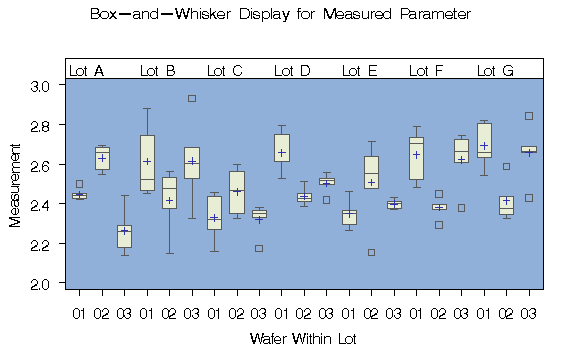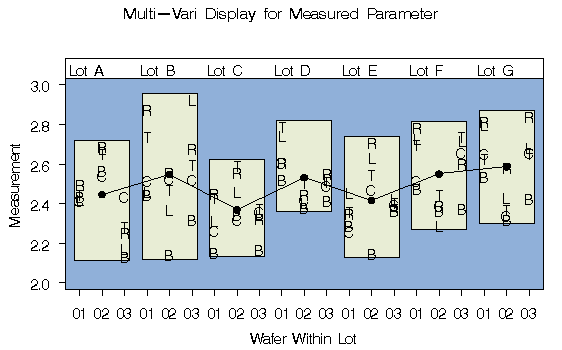Chapter Contents
Previous
Next
|
Chapter Contents |
Previous |
Next |
| BOXCHART Statement |
data parm;
length _phase_ $ 5 wafer $ 2 position $ 1;
input _phase_ $ & wafer $ & position $ measure ;
datalines;
Lot A 01 L 2.424
Lot A 01 B 2.441
Lot A 01 C 2.421
Lot A 01 T 2.449
Lot A 01 R 2.500
Lot A 02 L 2.681
Lot A 02 B 2.571
Lot A 02 C 2.546
Lot A 02 T 2.659
Lot A 02 R 2.692
Lot A 03 L 2.180
Lot A 03 B 2.135
Lot A 03 C 2.443
Lot A 03 T 2.290
Lot A 03 R 2.259
Lot B 01 L 2.465
Lot B 01 B 2.448
Lot B 01 C 2.523
Lot B 01 T 2.744
Lot B 01 R 2.883
Lot B 02 L 2.372
Lot B 02 B 2.145
Lot B 02 C 2.531
Lot B 02 T 2.474
Lot B 02 R 2.562
. . . .
. . . .
. . . .
Lot G 03 R 2.843
run;
The following statements create an ordinary side-by-side
box-and-whisker display for the measurements.
title 'Box-and-Whisker Display for Measured Parameter';
proc shewhart data=parm;
boxchart parm*wafer /
stddevs
nolimits
cboxfill = ywh
cboxes = dagr
cframe = vligb
cinfill = ligr
boxstyle = schematic
idsymbol = square
readphase = all
phaselegend
nolegend;
label measure = 'Measurement'
wafer = 'Wafer Within Lot';
run;

|
symbol v=none;
title 'Multi-Vari Display for Measured Parameter';
proc shewhart data=parm;
boxchart measure*wafer /
stddevs
nolimits
boxstyle = pointsjoin
cboxes = dagr
cframe = vligb
cinfill = ligr
idsymbol = square
cphaseboxfill = ywh
cphasebox = black
cphasemeanconnect = bib
phasemeansymbol = dot
readphase = all
phaselegend
nolegend;
label measure = 'Measurement'
wafer = 'Wafer Within Lot';
run;
Output 32.7.2: Multi-Vari Chart Using BOXSTYLE=POINTSJOIN

|
The option BOXSTYLE=POINTSJOIN specifies that the values for each wafer are to be displayed as points joined by a vertical line. The IDSYMBOL= option specifies the symbol marker for the points. The option V=NONE in the SYMBOL statement is specified to suppress the symbol for the wafer averages shown in Output 32.7.1. The option CPHASEBOX=BLACK specifies that the points for each lot are to be enclosed in a black box, and the CPHASEBOXFILL= option specifies the fill color for the box. The option CPHASEMEANCONNECT=BLACK specifies that the means of the lots are to be connected with black lines, and the PHASEMEANSYMBOL= option specifies the symbol marker for the lot means.
The following statements create a slightly different
multi-vari chart using the values of the
variable POSITION to identify the measurements for each
wafer.
Note that
the option BOXSTYLE=POINTSID is specified and that
POSITION is specified as the ID variable.
The display is shown in Output 32.7.3.
proc shewhart data=parm;
boxchart measure*wafer /
nolimits
stddevs
cboxes = dagr
cframe = vligb
cinfill = ligr
cphaseboxfill = ywh
cphasemeanconnect = black
boxstyle = pointsid
phasemeansymbol = dot
readphase = all
phaselegend
nolegend;
label measure = 'Measurement'
wafer = 'Wafer Within Lot';
id position;
run;
Output 32.7.3: Multi-Vari Chart Using BOXSTYLE=POINTSID

|
|
Chapter Contents |
Previous |
Next |
Top |
Copyright © 1999 by SAS Institute Inc., Cary, NC, USA. All rights reserved.